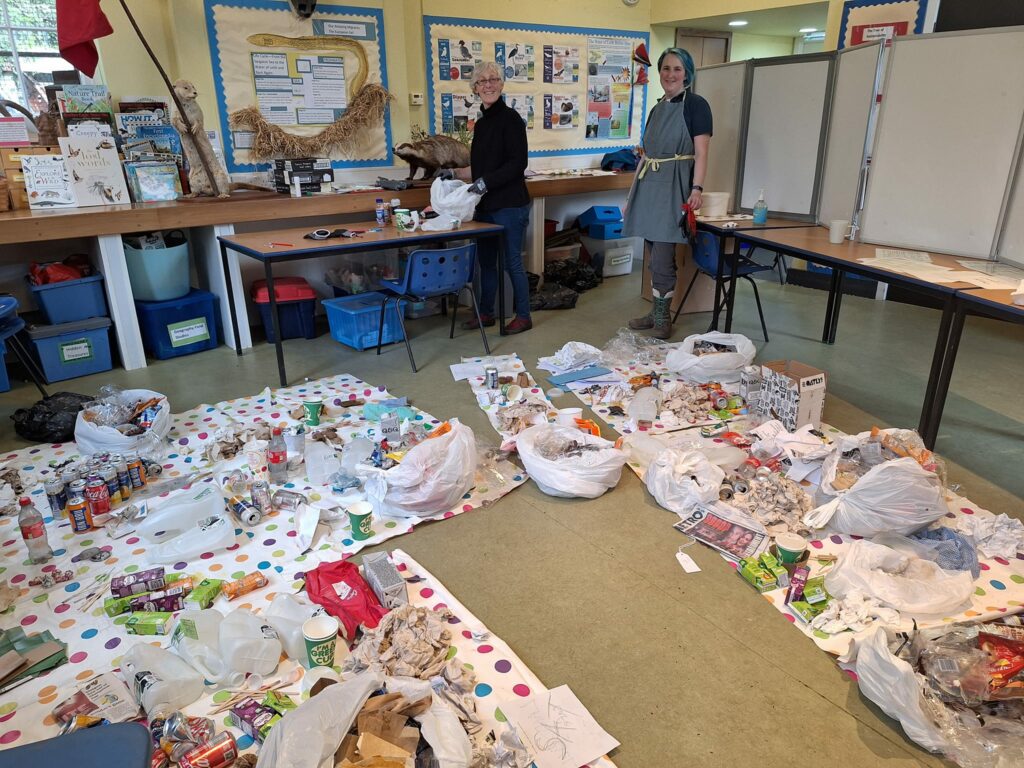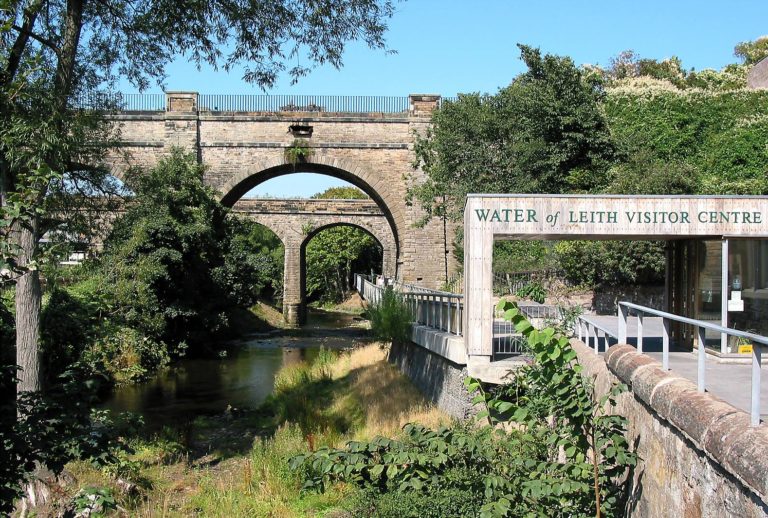Why are you rummaging around in the bins?
A couple of weeks ago we undertook a waste audit of the visitor centre as part of our journey towards zero waste. After all, you can’t see how well you’ve done if you don’t know where you started. Whilst some changes have already been implemented, we still have a lot of room for improvement.
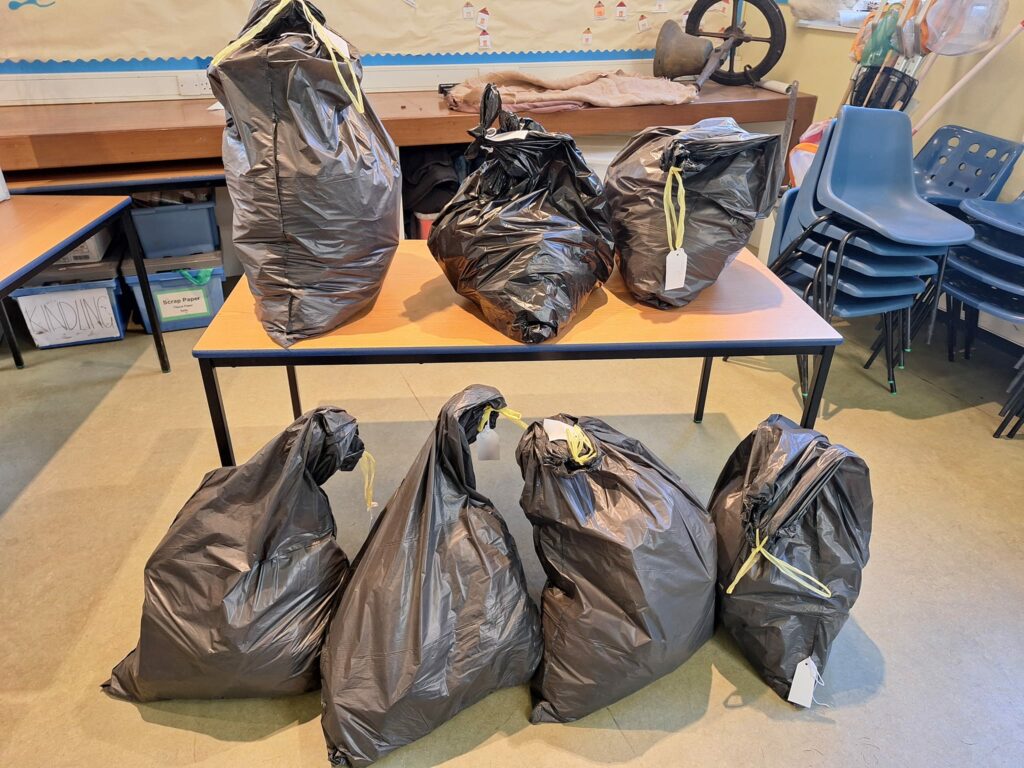
We assessed how much of each type of rubbish was created which will give us a benchmark to work against in future. We also sorted the contents by type of bin to assess how well (or maybe more correctly, how badly) we are sorting our waste pre-disposal.
Why is recycling so confusing?
Did you know that there isn’t a nationwide method for recycling? Every council recycles different things in different ways so it’s not surprising people find it confusing. In Edinburgh in their mixed recycling bins they’ll take cans, tins, plastic bottles, pots, tubs and trays, drinks cartons, empty aerosols, foil, envelopes, paper and cardboard… BUT only if it’s clean! Anything with food scraps, grease or liquid still on or in it risks contaminate the whole batch.
What did we find?
When we started the process, we knew some of the areas we needed to improve such as the wrapped cafe products but there were some definite surprises too!
All in all, we sorted through, counted and categorised 1533 items of waste (not including the toilet bins or the general food waste). Out of these items 38% had been disposed of incorrectly.
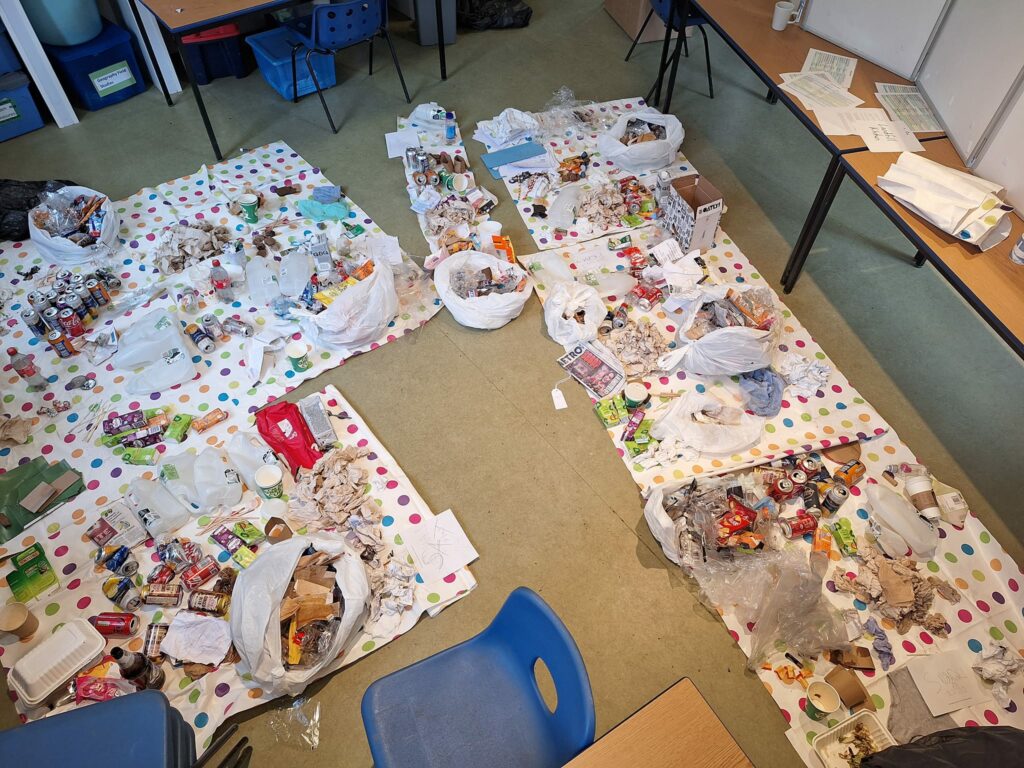
Food Waste
The worst culprits for incorrect disposal were items that could have gone in the composting/food waste bin. Our composting accepts commercially compostable items such as our coffee cups, lids, sleeves, stirrers and brown napkins. It isn’t so surprising this was worst by percentage when you take into account that for safety reasons (and the smell!) we didn’t keep the food waste for auditing, so no items were logged as the correct bin. However, this still amounted to 37 wooden drinks stirrers, 9 green takeaway cups, 8 coffee lids, 45 items of food waste and 250 brown napkins that should have gone for composting. Out of those 45 food items, 17 were teabags found in the kitchen bins where our staff and volunteers should know better! All the coffees we sell leads to a lot of sugar use 71 packets in fact. But which bin do you put them in? I’m still hunting for a definitive answer from Edinburgh Council but as the bits are often as small as shredded paper (which can go in paper specific bins but not mixed recycling; I said it was confusing!) we’re treating them as general waste there’s also a high chance of there still being sugar in them too even if they were the right size. As such, 42% were in the wrong bin.
Contamination and paper waste
I mentioned recycling needs to be clean and this was a big contributor to wrongly disposed of items in our bins. It just takes one can or carton not being empty and any paper or cardboard in that bin quickly becomes damp and must go into the general waste. As such, 9 pieces of cardboard and a shocking 37 pieces of paper that could have been recycled had to be chucked. A further 24 pieces of paper probably could have been recycled had they not become dirty in the general waste bin. Out of all our paper and card (215 items) only 60% could actually be recycled. We’ll be looking into ways to separate these from the main recycling to limit this in future! We also gathered the cardboard boxes and packaging that came in with orders which totalled 3kg of waste for recycling. Whilst we’re on items made from paper 20% of the 54 tissues that were thrown away were wrongly placed in the recycling bins. But they’re paper? True, but firstly most of them were used and secondly, the fibre they’re made from is too short for recycling even if they’re unused.
Packaging for drinks
When it comes to drinks we collected 52 cans, 8 were in the general waste, 2 still contained liquid and only 4 had been squashed to reduce volume of waste. 54% of the 24 juice cartons were in the wrong bin, 1 still with liquid in. Each of these also has a straw (which is now paper but not recyclable) but thankfully only 3 of those were disposed of wrongly. As none of our drinks come in plastic bottles, the 3 that were in our bins were from external sources, 1 was in wrong bin. When it comes to milk bottles (which our staff and volunteers were responsible for) there’s a bit of good news, all 17 of them were in the recycling bins! Unfortunately, 5 of them hadn’t been rinsed and it would really help the volume of recycling we produce if we got into the habit of squashing them too! Same story when it came to the 3 oat milk cartons too.
Food wrappers
The one source of waste we knew we would encounter a lot of was the wrapping from our cafe products. We are working behind the scenes to improve this but for now, we gathered a staggering 557 items related to cakes, crisps and snacks (387 plastic items and 170 paper liners from muffins and cakes that had to go into the general waste). That’s around one third of all our waste, definitely something we can improve on!
We’ve recently learned that soft plastics can be recycled at many supermarkets so we’re working out ways to collect these items but for now, the only method is general waste. Generally, people were pretty good with this, only 17 of the contaminated paper wraps and 13 plastic wraps made it into recycling by mistake. The other problem with prepackaged snacks is all the boxes of muffins and loaf cakes also come wrapped in plastic (14 pieces this week!). We don’t use much tinfoil other than on the tunnocks teacakes so only 9 pieces were found in the bins, but two thirds were in the general waste. That said, ideally tinfoil should be collected until it can be scrunched together to the size of a tennis ball… another thing for the to consider list.
We had 70 items of packaging from products we don’t sell. Of these 35% had been disposed of incorrectly.
Other items
When we began our move to reduce our waste, we realised the cleaning cloths were being thrown away when they could be washed and reused. I’d hoped this would mean none were found in the bins, but 3 useable cleaning cloths had still been thrown away rather than be put to be laundered.
Every day we have a big roll of till paper left from processing sales. Sadly, this cannot be recycled due to the chemicals involved in thermal printing. I should have measured the length of all the till roll as an interesting stat!
This brings us to our Miscellaneous category, also known as “items Kat didn’t think to put on the tally sheets” which contained an interesting array of items including: 35 offcuts from laminates, 6 pieces of fabric, 3 stamp packets, 2 broken mug handles (who knows where the mugs went!), 2 sticky labels, 2 glue sticks, 2 sticks from the great outdoors, 2 milk bottle lids (where did the other 15 go!?), 1 cigarette end, 1 broken foam house from the flood plain, 1 broken bug viewer, 1 teaspoon (in good working order), the metal bits of a cafetière and our most surprising…. a pair of pants! Out of all of these, only 20% had been put in the wrong bin.
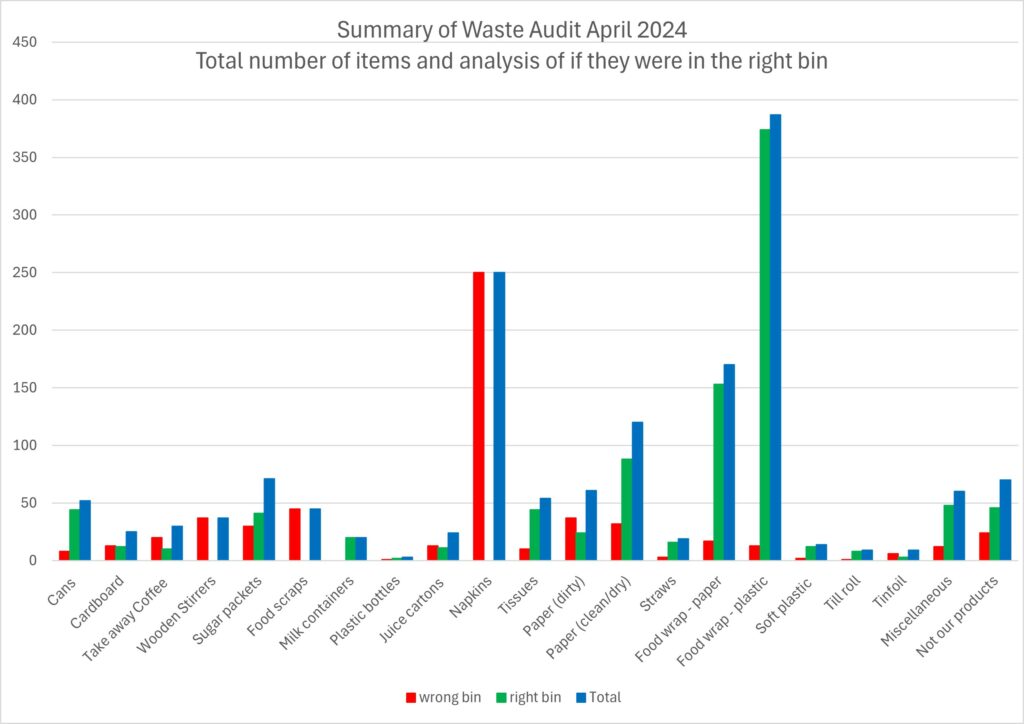
Best and Worst Bins:
We have been guilty in the past of thinking that maybe it’s our lovely customers that don’t put things in the correct bins. But is that the truth? Are the bins in the cafe our worst for wrongly disposed of items? I worked out a percentage of items wrongly disposed of in each bin type. Turns out that staff (and volunteers) can give themselves a nice pat on the back but also hang their heads in shame. The best bin was the general waste bin in our office with only 13.6% of waste wrongly disposed of! Good job staff team (but we were all hyper aware we were being audited and we don’t make much office waste anyhow!). However, our worst bin was also accessed only by staff and volunteers. The kitchen recycling bin had just shy of 65% of waste wrongly disposed of in it! Certainly lessons to be learned here about clear labelling!
The general waste bins were better than the recycling bins, both at 26% wrongly disposed of. The cafe recycling bin and the bin under the cafe counter both were around 44%.
What have we learned and need to change?
Other than giving us a benchmark to compare against in future, what are we taking away from this?
Below are a few of our key points for action
Paper and Card: Due to current contamination from liquids (which shouldn’t be happening anyhow) we will need to look at potentially separating the paper and card recycling from the main recycling.
Packaged products: A third of our waste was from packaged items sold in the cafe. We are currently looking to source fresh baked snack products which hopefully will go a long way to reducing this.
Soft plastics: This is a large proportion of our waste and it is not currently recyclable by the council. As well as looking at ways to reduce this, we will look into ways to implement a collection for this so it can be recycled at a local supermarket.
Cafe bin: Our bin by the cafe counter seemed to be used for everything rather than just general waste. As such we are going to look at removing this bin and adding separate bins for different types of waste in this area of the cafe.
Signage and Education: Whilst we have tried to make the bins as understandable as possible (even including images of items that are compostable) it still doesn’t seem to meet all criteria. As such, we will be looking at ways to improve signage and make it more obvious which items do or do not go in which bins. The kitchen bin signs have fallen off so need replacing. Whilst we recently did a training session with our volunteers on waste and recycling, staff and volunteers could clearly do with further reminders around this (remember those tea bags!)
Volume: As well as the quantity of recycling the volume of it is often made up through cans, cartons and bottles not being squashed. To reduce the volume we’re disposing of, a system for crushing cans may be useful and then it would prompt folk to empty them too and reduce contamination.
Feedback and Input: Have you seen a method for sorting bins that’s really easy to follow and understand? Did you see a great sign explaining things? Have you noticed why it’s hard to dispose of things correctly in the centre? If you have any feedback or suggestions of ways to stop us being rubbish with our rubbish, we’d love to hear them!


